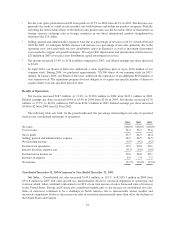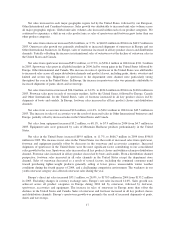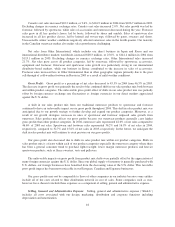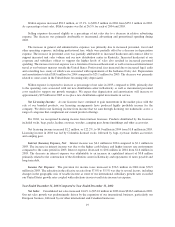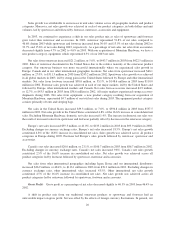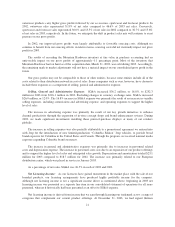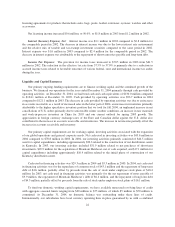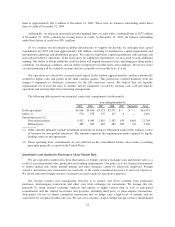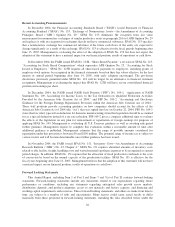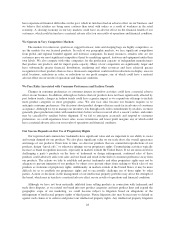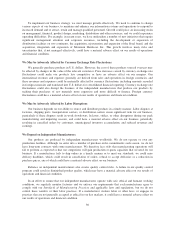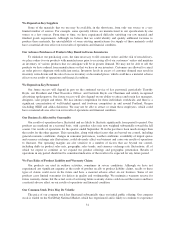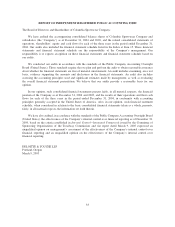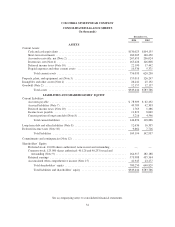Columbia Sportswear 2004 Annual Report Download - page 30
Download and view the complete annual report
Please find page 30 of the 2004 Columbia Sportswear annual report below. You can navigate through the pages in the report by either clicking on the pages listed below, or by using the keyword search tool below to find specific information within the annual report.from approximately one to two percent of sales. However, actual returns and claims in any future period are
inherently uncertain and thus may differ from the estimates. If actual or expected future returns and claims were
significantly greater or lower than the reserves that had been established, we would record a reduction or increase
to net revenues in the period in which we made such a determination.
Allowance for Uncollectible Accounts Receivable
We make ongoing estimates for the uncollectibility of our accounts receivable and maintain an allowance
for estimated losses resulting from the inability of our customers to make required payments. In determining the
amount of the allowance, we consider our historical level of credit losses and we make judgments about the
creditworthiness of customers based on ongoing credit evaluations. We analyze specific customer accounts,
customer concentrations, current economic trends, and changes in customer payment terms. Because we cannot
predict future changes in the financial stability of our customers, actual future losses from uncollectible accounts
may differ from our estimates. If the financial condition of our customers were to deteriorate, resulting in their
inability to make payments, a larger allowance could be required. If we determine a smaller or larger allowance
is appropriate, we would record a credit or a charge to SG&A expense in the period in which we made the
determination.
Inventory Obsolescence and Product Warranty
We make ongoing estimates of potential future excess, close-out or slow moving inventory and product
warranty costs. We identify our excess inventory, a component of which is planned, and evaluate our purchase
commitments, sales forecasts, and historical experience and make provisions as necessary to properly reflect
inventory value. When evaluating our reserve for warranty costs, we consider our historical returns rates by
season, product mix, current economic trends, and the historical cost to repair, replace, or refund the original
sale. If we determine smaller or larger reserves were appropriate, we would record a credit or a charge to cost of
sales in the period we made the determination.
Income Taxes
We use the asset and liability method of accounting for income taxes. Under this method, income tax
expense is recognized for the amount of taxes payable or refundable for the current year and for deferred tax
liabilities and assets for the future tax consequences of events that have been recognized in an entity’s financial
statements or tax returns. Management must make assumptions, judgments and estimates to determine our
current provision for income taxes and also our deferred tax assets and liabilities and any valuation allowance to
be recorded against a deferred tax asset. Our judgments, assumptions and estimates relative to the current
provision for income tax take into account current tax laws, our interpretation of current tax laws and possible
outcomes of current and future audits conducted by foreign and domestic tax authorities. Changes in tax law or
our interpretation of tax laws and the resolution of current and future tax audits could significantly impact the
amounts provided for income taxes in our consolidated financial statements. Our assumptions, judgments and
estimates relative to the value of a deferred tax asset take into account predictions of the amount and category of
future taxable income. Actual operating results and the underlying amount and category of income in future years
could render our current assumptions, judgments and estimates of recoverable net deferred taxes inaccurate. Any
of the assumptions, judgments and estimates mentioned above could cause our actual income tax obligations to
differ from our estimates, thus materially affecting our financial position and results of operations.
On a quarterly basis, we estimate what our effective tax rate will be for the full fiscal year and record a
quarterly income tax provision in accordance with the anticipated effective rate. As the calendar year progresses,
we periodically refine our estimate based on actual events and earnings by jurisdiction during the year. This
ongoing estimation process can result in changes to our expected effective tax rate for the full calendar year.
When this occurs, we adjust the income tax provision during the quarter in which the change in estimate occurs
so that the year-to-date provision equals the expected annual effective tax rate.
25



